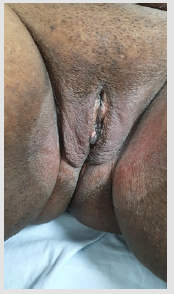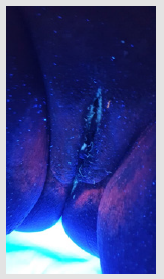Impact Factor : 0.548
- NLM ID: 101723284
- OCoLC: 999826537
- LCCN: 2017202541
Posso García Gustavo Antonio and Uribe Restrepo Andrés F*
Received: July 22, 2022; Published: July 29, 2022
*Corresponding author: Uribe Restrepo Andrés F, Residente de la especialización de dermatología, Universidad Libre de Cali, Médico y Cirujano, Universidad Libre Seccional Cali, Colombia
DOI: 10.26717/BJSTR.2022.45.007199
Erythrasma and lichen sclerosus are usually found as separate entities, however
it is rare for the two diseases to coexist in a patient in the same affected area. Next,
we present the case of an adult, Afro-Colombian, and obese patient with a primary
diagnosis of lichen sclerosus on the vulva, which is refractory to treatment with potent
topical glucocorticoids secondary to the association with erythrasma in the same area.
Summary:Erythrasma and lichen sclerosus are usually found as separate entities,
however it is rare for the two diseases to coexist in a patient in the same affected
area. Next, we present the case of an adult, Afro-Colombian, and obese patient with
a primary diagnosis of lichen sclerosus on the vulva, which is refractory to treatment
with potent topical glucocorticoids secondary to the association with erythrasma in
the same area.
Palabras Claves
Lichen sclerosus is a chronic disease that affects the skin mainly in the genital area, although it can appear in any region of the body. Its etiology is multifactorial and still to be elucidated, such as autoimmunity, genetic polymorphisms and interaction between infectious, hormonal and allergic mechanisms. It mainly affects Caucasian women between the ages of 40 and 60, although it can occur at any age, ethnicity, and gender. It is estimated to occur in 1 in 30 adult women and 1 in 900 prepubertal girls [1,2]. It manifests itself mainly with the appearance of erythematous papules that coalesce into plaques, which become hard and white. It is accompanied by symptoms such as itching and in chronic processes there is atrophy and retraction of the tissue. Symptoms depend on the location as do the areas involved. Lichen sclerosus may be associated with other skin dermatoses [2,3]. Erythrasma is a bacterial infection typically caused by Corynebacterium minutissimum, which infects the stratum corneum of the skin in warm, moist skin areas. Commonly affected sites are intertriginous regions such as the axillae, groin, and interdigital spaces. It mainly affects the elderly, obese and diabetics and presents as asymptomatic hyperpigmented red or brownish macules with scaling and central hypopigmentation, although they may be slightly raised. On the part of the erythrasma, coinfections with dermatophytes and Candida albicans can be found [4,5]. Here we present a rare case of lichen sclerosus coexisting with erythrasma in the area of inguinal and genital intertrigo.
Clinical Case
A 59-year-old patient with a history of obesity, with a 1-year evolution of confluent hypopigmented macules in the labia minora in a figure 8 distribution pattern (Figure 1).
Figure 1.Hypopigmented maculas confluent in vulvar region are observed in distribution in 8 compatible with lichen sclerosus and atrophic, however it is possible to glimpse crural erythematous area.

Figure 2.It is observed with the application of Wood’s Light, red-coral refraction in crural area, which is characteristic of erythrasma.

Biopsy report with hyperkeratosis, orthokeratosis, follicular plugs, areas of acanthosis and epidermal atrophy, in the dermis with eosinophilic hyalinized collagen and telangiectasias with infiltrate of band lymphocytes compatible with lichen sclerosus et atrophicus. Management was given with Clobetasol 0.05%, but it developed perilesional hyperpigmented macules, which showed perilesional coral red fluorescence with Wood’s light, for which an added diagnosis of Erythrasma was made (Figure 2). It was decided to add 2% topical erythromycin to the previous management in hyperpigmented plaques for 14 days, after washing with syndet soap. Attend control with improvement of symptoms.
Lichen sclerosus et atrophicus in women has been associated primarily with autoimmune diseases such as psoriasis [6], vitiligo, and alopecia areata. Borreliosis, atypical mycobacteria, and human papillomavirus and hepatitis C have been suggested as possible infectious agents [7]. Coexistence with herpes simplex infection or candidiasis has been observed [2]. For its part, erythrasma is a bacterial skin infection that occurs mainly in intertrigos of obese and diabetic patients [8]. Being the main treatment in lichen scleroatrophicus with high potency topical corticosteroids, treatment failures may be implicated in case of superimposed infections [2]. We present a rare case of coexistence of vulvar lichen scleroatrophicus and genital erythrasma.


